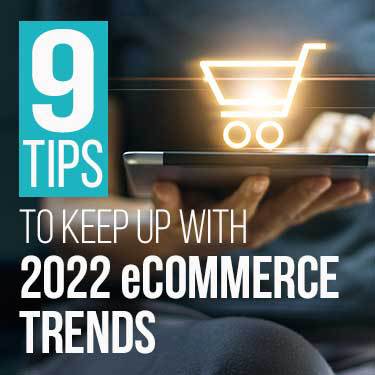
 Copy URL to Clipboard
Copy URL to Clipboard
2022 eCommerce trends are taking online platforms to new levels. A new year means new opportunities for success. After exploding in the wake of the coronavirus pandemic, eCommerce continues to grow and shows no signs of slowing down. We’ve got 9 tips for 2022 to help you reach new levels of success.
Work smarter, not harder, and check out 9 tips for keeping up with 2022 eCommerce trends.
Learn how to put these into practice to boost your business.
The ability to utilize even some of these tips can make it possible for you to have a share of the billions dollar industry that is eCommerce.
Table of Contents
According to data from Statista, from 2020 to 2021 the eCommerce industry grew from $431 billion to $469 billion. In 2022, it's expected to grow another 14% and within the next three years is likely to include over 270 million customers.
If you haven’t looked at eCommerce as an avenue for your brick-and-mortar stores yet, you need to. If you have, then you should also understand it is a market of constant growth, and keeping up with changes is vital to success.
To keep riding the eCommerce market wave, plan ahead now for how you market your site and merchandise. At the same time, learn to anticipate and track changing customer tastes and needs during the shopping experience. The increase in customers are now online doesn’t mean they don’t miss some of the user services often available for in-person shopping.

No business, online or brick-and-mortar, can survive without marketing services. If people don’t know how to find you or what your exact products are, you aren’t likely to be in business for long. When it comes to marketing strategies for your eCommerce business, take advantage of the many web-based tools at your disposal.
These online tools are evolving with the market and are often geared specifically to eCommerce needs. You don’t need to reinvent the marketing wheel as you start your business or when expanding a brick-and-mortar store to an online platform.
Another significant area that in-person and online customers have in common is their desire for various user services. Offering great products is important. Offering great products and great customer service takes business to another level.
Applying innovative technology to sales and giving customers options to choose from is part of offering useful and friendly customer service.
Combine best practices in both these categories to give your eCommerce business its greatest chance at success.
Contracting social media influencers has become a successful web-based marketing tool. This is a practice referred to as social commerce. Although some influencers get a bad reputation, building a brand with social commerce has proven successful for many eCommerce businesses large and small.
According to a recent study, over 230 million Americans use social media. That is nearly 70% of the United States’ entire population.
More people are now learning about products through social media sites. If a person browsing through social media sees an interesting product, the ability to buy it right away makes a difference. Many social media platforms already offer or plan to release updates allowing users to buy directly.
Platforms already offering on-site purchasing or who soon will include:
The spread of quick payment options through Google and Apple, which can be activated on multiple apps, makes purchases even easier.

Marketers have been taking advantage of people’s attraction to visual advertisements from the start. Whether through print or video, giant billboards or pop-ups, visual elements matter.
The ultimate visual element now is video - and better yet, you don’t actually need to hire a full production crew to make one. Between improved mobile technology and the rise of video-based social platforms, anyone with a smartphone can take a video and post it online and it can look professional.
eCommerce businesses can easily take advantage of videos for:
Quality video doesn’t need to come at a premium price anymore. Take advantage of it for your business and take the opportunity to integrate it with other marketing tactics such as social commerce.
It's not a VIP program, but you can make it feel like one. Providing excellent customer service increases customer retention. Brick and mortar stores have been offering loyalty programs to customers for years, often in the form of an extra key chain tag you could carry around. eCommerce sites can and should offer the same (with no key chain necessary, unless they want to buy one of course).
Loyalty programs build trust and create brand loyalty by making special offers to repeat customers. Free gifts, special discounts, and exclusive offers are all tools that can be used with a loyalty program.
These programs provide other benefits as well:
Remember, customers have more options now than ever. Online stores offer variety and distance is removed as a factor. Offering a loyalty program is a relatively simple and cost-effective way to track customer journeys for long-term profit.

Online shopping is generally considered more eco-friendly than traditional retail stores. When offering products and services through eCommerce platforms, there’s no need to take up space with a physical store. Plastic shopping bags become a thing of the past. Even such things as paper receipts are eliminated.
Going the extra step to build green practices into multiple aspects of your business is another way to expand your customer base. According to a 2021 survey, nearly 9 out of 10 consumers consider a company’s environmental impact when choosing to buy.
When choosing between similar brands, sustainability may be the determining factor for many customers.
There are different ways online retailers can “go green” for sustainability:
Making your eCommerce sales more sustainable is more than just good business. At the end of the day, you are also making a difference in the world and that is good for everyone.
You might be fooled into thinking that augmented reality (AR) is just for video games and the occasional scannable advertisement. Truthfully, AR apps are the latest tools being offered to customers making purchases online to give them a “feel” for what they are buying.
Certain furniture companies are offering AR within their apps that allow customers to see how a piece might look in their home. Others allow users to virtually try on glasses through a filter.
AR technology allows eCommerce to offer a “try before you buy” service. Shoppers can get a better idea of how much they like a product and buy with confidence, hopefully reducing the rate of returns.
For those building up social commerce marketing, you can check out Spark AR Studio which works with Facebook and Instagram. Providing AR for your customers might give your business a unique (and fun) edge.

The most common payment options for online shopping, credit card and direct debit, still remain popular. Familiarity and ease of use make these a must for your eCommerce business.
Growing in popularity are digital wallets. These are services that store your debit or credit card information for online or mobile purchasing. Digital wallets tend to come with safety features, such as 2-factor authentication and PINs, that bring users peace of mind when shopping online.
Some common digital wallets are:
The last two are nearly exclusive to the products they are available on.
A third option referred to as “Buy Now Pay Later” or BNPL, is now being made available through some online retailers. The option is pretty self-explanatory. Customers are given the option during check out to pay in equal installments through a debit or credit card. Usually set up as a ‘pay in 4’ model, you can set up four equal payments, two weeks apart, to be billed automatically.
For buyers who wish to avoid financing purchases or are unable to, BNPL presents a good option. Most BNPL services don’t run credit checks or charge interest. Late penalties, if they have them, tend to be reasonable.
eCommerce sites that have implemented BNPL payment options have noticed several benefits:
While a great option to increase user services, eCommerce sites looking into offering this option should carefully explore the banks and credit providers they would need to use to do so.
In places where quarantines and curfews are still in effect, traditional store browsing has almost disappeared. Videos and accurate descriptions are great, but the interaction between business and consumer is distant or non-existent.
Enter the live stream shopping experience where you can add items to your online shopping cart during live presentations of the product. Live shopping can be considered the tech age equivalent of the Home Shopping Network.
During presentations of a product, customers can interact directly with presenters either through text or voice chat. They gain the benefit of speaking with ‘store associates’ but don’t have to leave the house.
Live shopping is a powerful eCommerce tool, especially when used together with social commerce and other marketing tools.
Live shopping experiences have been used for:
As the technology improves and becomes available on more platforms live stream commerce may become a new standard. Even major retailers like Walmart, who recently paired up with TikTok for a live-streamed shopping experience, are taking advantage.

Part of running a successful eCommerce site this year involves the ability to balance customer desires. Customers want the benefit of human interactions but the ease of automated services. For sites that are more involved in B2B eCommerce, automatic systems make for faster transactions.
Once sales are made and customers are attracted, you want to make it easy for them to keep buying. Parts of your site that may be better left to automation include:
Automated services also help build regular revenue. Having subscription members or companies with pre-set deliveries brings in a steady profit that can get you past seasonal sales slumps.
See our article on subscription boxes to see if this service is a good fit for your business.
People have grown used to getting just about everything they need delivered to their doors. It's the service that catapulted eCommerce sales at the start of the Covid-19 pandemic when people were stuck at home.
However, the pandemic’s impact on the shipping industry has also made this service more expensive and harder to guarantee. The ability to offer free shipping as a customer draw is often out of reach for smaller operations. eCommerce stores wishing to continue this service or start offering it may need to come up with creative solutions.
One such solution is to outsource shipping, as well as warehousing, to a third-party logistics company, or 3PL. Pairing with the right 3PL allows you to outsource the more time-consuming and expensive parts of the business, such as inventory management and fulfillment services.
Using 3PL services with pre-established infrastructure around the country can allow you to continue offering home delivery while also consolidating other parts of your business.
Starting your own eCommerce business is exciting. Updating your current practice is a big step that might seem a little scary. Partnering with R+L Global Logistics to help you get started or transition into new practices means you are working with an industry leader that can steer you in the right direction.
Online shoppers have an insane amount of options to choose from. Make your business stand out in 2022 with eCommerce trends that offer best practices for marketing and friendly user services.
R+L Global Logistics can partner with your company to offer 3PL warehousing, pick and pack fulfillment, and kitting services. For those hard to please customers, we also offer reverse logistics services to handle returns.
Get a quote for your business today to stay ahead of the trend and stay on track with business goals.
